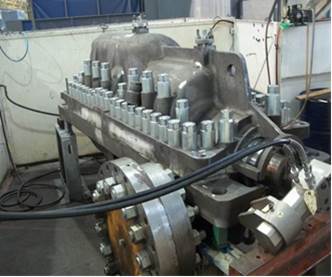Pump Casing Hydrostatic Test
The pump casing hydrostatic test is performed after successful completion of the pump casing inspection. The casing shall be tested by liquid at the 1.5 times of maximum allowable working pressure. The pump hydrostatic test pressure can be found on the pump datasheet.
2 Free CPD Hours Courses - Completely Free
Enroll, Watch the Video, Take the Test, Download Your Cert and Submit to the API . 2 free courses are availble each with 2 hours credit. (Total 4 hours) - 1) ASME V Articl II , 2) ASME V Article 6 & 7
The inspector does not need to calculate the test pressure since this is calculated by manufacturer pump designer and approved by customer pump SME (Subject Matter Expert). The inspector should make sure the pump casing hydrostatic test procedure is being submitted to the customer and being approved.
Pump Casing Hydrostatic Test in API 610
The water temperature for testing shall be higher than casing material transition temperature from ductile to brittle fracture. The material transition temperature can be obtained from the metal handbook, or ASME Code Section VIII Div.1 USC-66 curve A, B, C, D can be used as a guide.
This requirement avoids from catastrophic brittle fracture during hydrostatic testing.
As you might know, the material loses its toughness below the certain temperature (it is different from material to the material) and a small imperfection in the casing body can lead to the fracture if the testing liquid temperature is less than the material transition temperature.

The API 610 also requires that the wetting agent being added to the testing liquid in the certain condition. The most important ones are when the pump service has the specific gravity less than 0.7 (the specific gravity can be found in the pump datasheet) or when the pump design temperature is higher than 500-degree Fahrenheit.
The code requires the test liquid chloride content be less than 50 ppm for casing with stainless steel material to avoid stress corrosion cracking. Besides, upon completion of the test all testing water shall be removed and dried instantly.
As per API 610, the casing shall be under hydrostatic pressure for minimum 30 minutes. The hydrostatic test result shall be considered satisfactory if no leak or seepage observed from pressure containing part.
The mechanical seal shall not be included in the casing hydrostatic testing. If seal chamber is a removable type, then shall be tested separately.
The pump casing cooling water passages, (if any) bearing jackets and seal chamber, etc. shall be tested at minimum 150 PSI.
The steam, lubricating oil and cooling water piping system shall be tested at the 1.5 times of the Maximum Operating Pressure or 150 PSI whichever is greater.
The hydrostatic testing shall be performed by calibrated pressure gage, and the inspector shall verify the calibration and expiration dates. The preferable range of pressure gage shall be twice of the test pressure but in no case shall be less than 1.5 times and not more than 4 times of the test pressure.
For example, if test pressure is 1000 PSI, the best pressure gage for testing will be 2000 PSI pressure gage. As per above requirements the 1200 PSI and 5000 PSI pressure gages will not be acceptable.